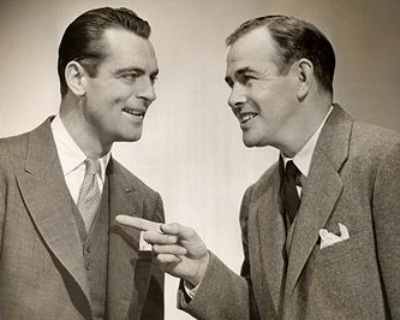
With our archives now 3,500+ articles deep, we’ve decided to republish a classic piece each Sunday to help our newer readers discover some of the best, evergreen gems from the past. This article was originally published in March 2013.
We’ve done several articles on the Art of Manliness covering the wonderful art of conversation, from its dos and donts, to how to make small talk, to avoiding the dreaded plague of conversational narcissism.
A comment each of those posts invariably received was, “This is great. But, uh, how do you end a conversation?”
Watch the Video
We would all be well-served by striving to engage in more face-to-face conversations, taking the time to listen to others, and doing our best to add to the back and forth of our daily interactions. But there are times when the conversation is truly going nowhere and/or we need to go somewhere. So yes, the question naturally arises . . . how do you end a conversation without making it overly awkward or offending the other person?
It isn’t easy. Approaching someone might make you nervous but it consists entirely of positive behaviors – coming over, smiling, starting some small talk. Exiting a conversation, on the other hand, is made up of negative behaviors – stopping talking, backing away. No matter how amiable your intentions, the person can feel like you’re rejecting them. This isn’t a big deal if you’re never going to see the person again, but if you will, you don’t want things to be awkward (and you truly don’t ever know for sure whether you’ll meet someone again, so why burn any bridges?). And if the person is actually someone you do want to see in the future, but you just don’t have the time to talk to them at length at the moment, you want to solidify your connection and leave things on a positive note.
There’s no magic formula for making an exit that guarantees the person won’t take offense. But there are several things you can do to disengage in the smoothest, most dignified way possible – minimizing the awkwardness, sparing the person’s feelings as much as you can, and shoring up your rapport with someone you want to reconnect with later.
These tips may be combined or used separately depending on your situation. Many apply both to face-to-face conversations and those conducted over the phone.
Have a clear purpose/agenda in mind. Whether you’re going to a party, a networking event, or simply the bathroom, have an agenda in mind for what you want to accomplish. Do you want to meet a lovely lady? Make a connection with someone who can help you redesign your website? Empty your throbbing bladder? Whenever you’re trapped in a conversation, you’re torn between potentially hurting someone’s feelings by moving on and wanting to do something else. Having a clear purpose in mind for what you want to get done gives you the motivation to choose the latter. It also gives you some easy-to-create exit lines, as we’ll discuss below.
Wait for a lull in the conversation. “Well.” “Okay.” “Anyway.” “So.” Such words emerge when a conversation has momentarily stalled. They’re turning points where either a new topic can be introduced, or the conversation may draw to a close. As such, they’re the perfect opportunity to begin to disengage. The speaker will say “So,” with an upward lilt in the voice, hopeful of the continuation of the conversation. You answer with a tone of more downbeat finality: “So.” And then you quickly transition into your exit line. “So, listen, it’s been great catching up with you . . .”
Bring the conversation around to the reason you connected in the first place. When possible, this makes for a smooth ending. Did the conversation start by you asking someone for their recommendation for a class to take? End with, “Well, I appreciate the tip. I’ll definitely try to get into that class during enrollment.” Did it start by someone asking you to take care of a problem at work? Close things out with, “So I appreciate you bringing this to my attention. I’ll definitely send Jim an email this afternoon to figure out what’s going on.”
Use an exit line. This is where having an agenda as outlined above really helps. When it comes to what kind of exit line to use, first, be honest. Fabricating excuses is tempting, but it can come off as dishonest in the moment and lead to more trouble later if the truth gets out. Second, put the emphasis on what it is that you need to accomplish. This makes your exit seem less like a judgment of the other person — it’s not about them, there’s just something you need to do. Here are some examples of exit lines (likely prefaced by a “Well…”):
- I need to get a seat/use the bathroom before the movie starts.
- I have a question I wanted to ask the speaker before he leaves.
- I’ve got to get back to work. I’ve got a deadline I need to meet before noon.
- I want to make sure to say hello to everyone here.
- I’ve got to go inside and start getting dinner ready for the kiddos.
- I’m hoping to see the Romantic art exhibit before it closes.
If you initiated the conversation, but now want out, and there isn’t something you’re hoping to do, try a line that brings closure to a conversation by implying you’ve crossed something off your checklist (“just” is your friend here):
- So, just wanted to make sure everything was okay.
- Well, just wanted to see how the new job was going.
If the other person initiated the conversation, and did so to ask for help/advice, conclude things by asking:
- Is there anything else I can help you with?
- Is there anything else you needed?
For a situation where the above exit lines aren’t appropriate, simply wait for a conversational turning point and say something like:
- Well, it was great catching up with you.
- Anyway, it was fun to see you again.
Using the past tense in such lines tells the other person that the conversation has come to a close.
Another type of all-purpose exit line is something like:
- Anyway, I don’t want to monopolize all your time.
- Well, I don’t want to keep you from your work.
I’d only use the above lines, however, when your conversation partner does indeed look like they want out, or you simply can’t think of anything to say. They can come off as a bit condescending — after all, if they really minded you taking their time, aren’t they capable of saying so themselves? You also run the risk of them jumping in with, “Oh no, I don’t mind at all!” and the conversation continuing on. Finally, generally when you hear such lines from someone, they clearly register as a getaway attempt.
Introduce the person to someone else. If one of the above exit lines won’t do the trick, try introducing your conversation partner to someone else. “It was great talking to you, Paul. There’s someone else I’d like you to meet. My friend Sam over here is also in software design.” Walk your conversation partner over or flag down your friend. Then say, “I’ll let you guys talk.” Now you should only employ this method if you genuinely think the two would mutually enjoy the connection. You don’t want to pawn an insanely boring, or simply insane person on someone else just so you can wriggle away.
Get the person to introduce you to someone else. This is a good method for networking-type events. Ask the person if they know someone that can help you with a problem:
- Do you know anyone who’s dealt with the guys who run ___?
- I’m really interested in ___? Do you know anyone with experience in that?
- I’ve been wondering how to get started with ___? Do you know anyone who’s done that?
- Can you suggest anyone who could help with ___?
If your conversation partner does know someone who can help with your request, they’re likely to take you over to meet him or her. If they don’t, you can simply say, “Well, I really need to find someone who can help me with this. I’m going to ask some more people.” Either way you’ve just smoothly extricated yourself from the conversation.
Invite the person to do something with you. This allows you to make a possible exit/continue on to what you wanted to do without your conversation partner feeling abandoned, and allowing them to still feel wanted. Say something like:
- I’m going to try to meet the speaker. Do you want to come?
- I’m ready for another drink. Want to go over to the bar with me?
- I want to check out the Picasso exhibit. Do you want to go see it?
- Let’s check out the buffet.
- My friend Mike just walked in. Let’s go say hi to him.
If the person declines your invitation, well, you’ve successfully ended your conversation with them. If they accept the invitation, you can hook up with some more people who can liven things up, and you can keep after whatever your original agenda/purpose was before you got pulled into the conversation.
Bow out when others join the conversation. This is a standard, tried and true method. Once other people join the circle of conversation and things get going between your old partner(s), you slip away.
End with appreciation. Whichever of the above methods you employ to exit a conversation, end the interaction with appreciation. Small talk expert Debra Fine calls appreciation “a compliment with closure.” Recap the conversation in a positive way, thank the person for giving their time, sharing their expertise, or simply being fun to get to know, and be sincere — only say it if you mean it. Use their name too — it builds a last bit of rapport (and it helps solidify their name in your memory if you just met them). This kind of goodbye ensures you go out on a high note, with warm feelings between you.
- Thank you for sharing your thoughts on going to law school, Sean. It really helped me think though my decision.
- It was wonderful catching up with you, Sarah. I haven’t laughed that hard in a long time.
- I appreciated getting your thoughts on the issue, Dan. I’ll take care of it as soon as possible.
If you didn’t appreciate the conversation, and don’t want to encourage the person to strike up another one next time they see you, just end with one of the exit lines above, and then a simple, “Okay, take care,” or something similar.
Smile/shake hands/make plans. Before you go, give them a smile and shake their hand. Like using their name, it adds an element of personal warmth and rapport-building to your exit. Once you shake hands, start to physically back away to avoid the possibility of the conversation springing back to life.
If you’d like to see the person again, tell them so, and ask for a phone number/email/business card. If you feel like things went well, despite your need to bounce early, make specific plans for when you’ll talk/meet up again.
Purposefully head to your destination. Fine argues that “The cardinal rule of the exit is that when you depart, you do what you said you were going to do.” If you say you need to find a seat before class starts, but then walk ten feet, and start talking to someone else, your jilted conversation partner is going to know you lied and dumped them. Likewise, if you say you need to go talk to someone else, but then she sees you wandering aimlessly through the party looking lost, she’s going to feel hurt. Our eyes are attracted to movement — people will notice. Go with deliberate purpose to do what you said you needed to do.
If all else fails, you can always make like the writer George Plimpton, who always carried around two drinks at events. If he found himself stuck in an unwanted conversation, he’d politely extricate himself by saying he needed to deliver the other drink!
At the end of the day, employing the above methods can help you avoid awkwardness and hurt feelings, and strengthen a connection you hope to revisit at another time. But if being polite doesn’t work, sometimes you just need to be assertive, bid the person good day, and turn heel. You wouldn’t let someone stand there and pick your pockets, would you? Time is worth far more than money. Don’t let people rob you of it.
For more tips on ending a conversation, and the art of small talk in general, listen to our podcast with Debra Fine:
Sources:
The Fine Art of Small Talk by Debra Fine
The Art of Conversation by Catherine Blyth
Small Talk, Big Results by Diane Windingland







